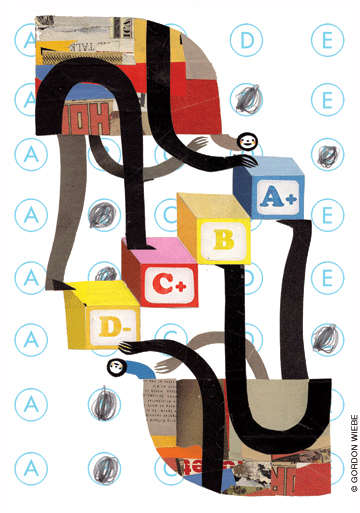
America’s obsession with academic proficiency is a dead end. Can an alternative model get us back on track?
By Walt Gardner
As school districts across the country struggle in vain to close the persistent academic achievement gap between students from different ethnic, social, and economic backgrounds, even longtime supporters of public education are beginning to ask if anything will work. It’s a fair question, particularly at a time when pressure is mounting to prepare students for the demands of the new global economy. But answering it requires putting aside ideology and examining the evidence.
The problem starts with the uncontested fact that no standard can simultaneously be achievable by, and challenging to, all students. There is simply too much natural human variation in intelligence and motivation. It’s possible to establish a standard that is minimal, but it will pose no challenge to average and advanced students. It’s also possible to establish a standard that is challenging, but it will be unreachable by most below-average students.
High-blown rhetoric will not change this reality. When the No Child Left Behind Act took effect in 2002, its goal was to have all students proficient by 2014. But as teachers maintained from the beginning, this was patently absurd. In fact, the only reason that some states have been able to claim success in reaching proficiency is by lowering the bar—setting the scores for proficiency at a point likely to yield the desired outcomes. Predictably, this has created a crazy quilt of state standards that renders the notion of proficiency virtually meaningless and makes a blatant travesty of the spirit of the law. As a result, confidence in public schools has been undermined precisely when it is most needed. Realizing that proficiency is misleading, some states are moving toward a fairer and clearer way of assessing student learning and instructional effectiveness. Instead of obsessing over the proficiency scores of entire classes and schools, they are focusing on the individual progress each student makes under the tutelage of his or her teachers.
First introduced in Tennessee in 1992, this “value-added” or “student-growth” model is attracting increasing attention as a way of identifying effective teachers—especially since it dovetails with the growing popularity of pay-for-performance plans, another revived prescription. The U.S. Department of Education has permitted eight states to implement the value-added model so far, and more are expected to join them in coming years. There is much to recommend this approach. Traditional notions of “teacher accountability” involve comparing the test scores of this year’s fifth-grade class, for example, with the scores recorded by last year’s crop of fifth graders. By contrast, the value-added model tracks test-score gains of individual students over time.
While far from perfect, the value-added metric gives due credit to schools serving large numbers of disadvantaged students who bring huge deficits in socialization, motivation, and intellectual development to class through no fault of their own. According to Department of Education data, these students are already three months behind the national average in reading and math skills when they enter kindergarten. They may never reach proficiency, but their teachers would at least be rewarded for the growth that they produce.
Conversely, schools with large numbers of advantaged students would not be allowed to stand still because of the halo effect created when they happen to inherit students already performing at proficiency level. They would have to demonstrate improvement for their individual students or risk sanctions. At the very least, teachers would not qualify for bonuses without evidence of student progress under pay-for-performance plans.
Critics argue that judging students against themselves rather than against a stipulated objective standard would create a double standard—one for high achievers and one for low. But public schools are required by law to enroll virtually everyone who shows up at their doors, regardless of ability, desire, or motivation. Given the vast range of capabilities and deficits in any large population, expecting all students to reach an arbitrary high standard is a prescription for failure and a disincentive for the best teachers to teach in the toughest schools, where they are needed most. Moreover, defining proficiency down amounts to a betrayal of students capable of stretching themselves toward loftier standards of excellence.
Yet there are drawbacks that will have to be addressed, especially if teachers are to get on board. In England, where the value-added model has been used since 1992, a recent report in The Guardian showed that the gap between rich and poor students on the test for the General Certificate of Secondary Education has widened. As in the U.S., the controversy has centered on what part of the value added to students is attributable strictly to instruction and what part is the result of factors beyond the control of schools. When students move from one neighborhood to another, for example, they are exposed to a host of elements that affect their school performance. By the same token, when parents move up the socioeconomic ladder by virtue of promotions at work, they are in a better position to provide their children with travel, summer camp, and other enriching experiences. These changes affect school achievement and yet are not necessarily the result of instructional effectiveness.
All these considerations take on new relevance in light of the burgeoning pay-for-performance movement in the U.S. The two national teachers unions are wary about linking teacher compensation to test scores that may reflect influences distant from the classroom. But while the National Education Association opposes pay-for-performance plans outright, the smaller American Federation of Teachers supports efforts that reward teams of teachers whose individual students show progress.
This is an important point, and one that formed the foundation of Denver’s unique pay-for-performance plan in 2005. It rewards teachers in accordance with any one of nine measures, including student-growth objectives. The joint union-district plan constituted the blueprint for a model adopted by Minneapolis last year, and is now being studied in 14 other states and the District of Columbia.
This is essential if the best teachers are to be attracted to the worst schools. Beset by the retirement of veteran teachers and the flight of younger faculty, schools in the inner cities are increasingly turning to so-called “combat-pay bonuses” to recruit and retain teachers. But teachers have every reason to turn down such incentives if they are to be individually judged solely by the proficiency of entire classes of students on standardized tests. This is particularly the case once word travels through the grapevine about the daunting task of trying to educate students from chaotic backgrounds. And even if they decide to try, they won’t stay, as witnessed by a nationwide teacher turnover rate of 50 percent within the first five years in the classroom.
The most promising part of the value-added model is the possibility that it will return us to what effective teaching is all about: expanding all children’s knowledge and capabilities as far as they can go, regardless of how far ahead or behind they are to begin with. That alone makes it worth serious consideration.
Walt Gardner C’57 taught for 28 years in the Los Angeles Unified School District and was a lecturer in the UCLA Graduate School of Education. He may be contacted at [email protected].




